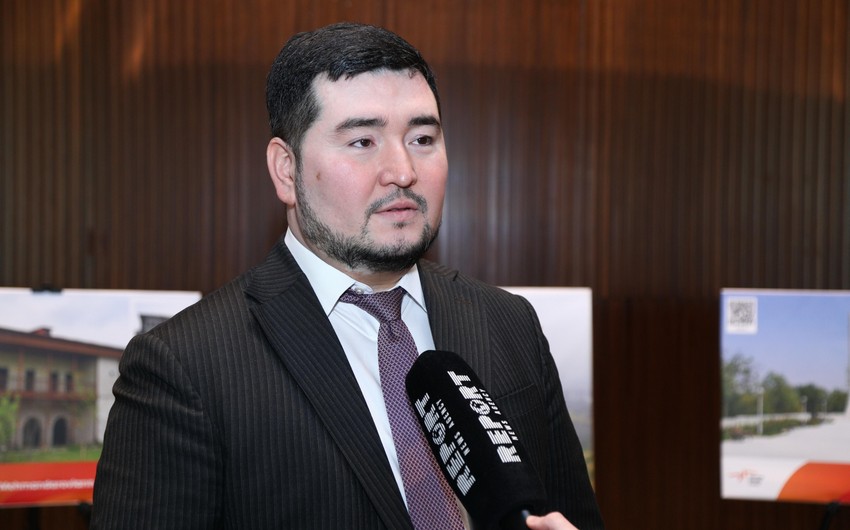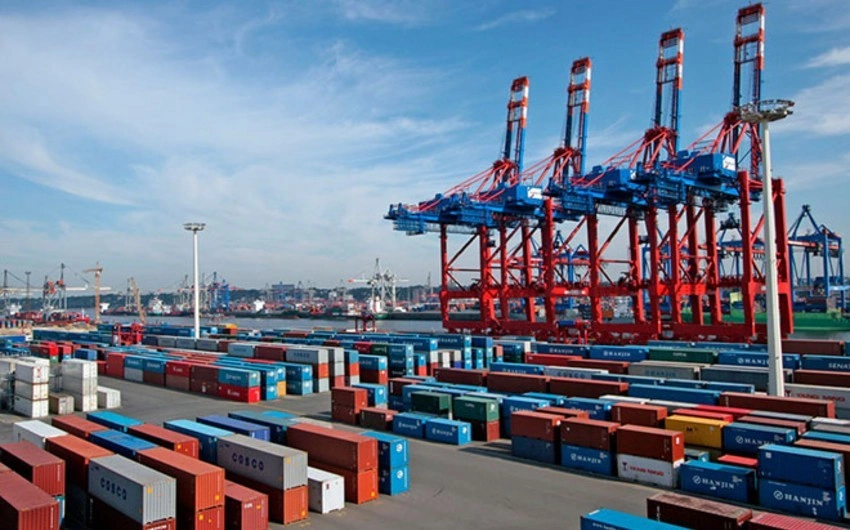TITR Sec.-Gen.: Negotiations underway to attract new countries to Middle Corridor
- 12 March, 2025
- 14:03

Development of the Middle Corridor (Trans-Caspian International Transport Route - TITR) has become one of the key topics in global logistics. This route, connecting China, Kazakhstan, the Caspian Sea, Azerbaijan, Georgia, Türkiye, and Europe, is attracting increasing attention as an effective alternative to traditional transport routes.
In an interview with Report, Secretary General of the International TITR Association Gaidar Abdikerimov discussed current and prospective infrastructure projects, expected growth in cargo flow, implementation of digital solutions, as well as Azerbaijan's role in the corridor's development.
Report presents the interview:
- What infrastructure projects are planned for the development of the Middle Corridor in the short and long term?
- Currently, a large-scale roadmap is being implemented within the TITR corridor, aimed at synchronously increasing the route's capacity. This project covers the territory from China through Kazakhstan, Azerbaijan, Georgia, and further through Türkiye to Europe. The Middle Corridor development program is designed for 5 years - until 2027 inclusive. As part of this work, we will create high-quality infrastructure for transportation and logistics. At the moment, we are observing significant progress in expanding the corridor's capabilities. Kazakhstan, Azerbaijan, and Georgia are actively investing in both technical development and organizational aspects to improve the route's efficiency. All participants are making significant efforts aimed at modernizing and synchronously developing infrastructure, which will ensure stable growth in transit transportation.
- What are the medium-term forecasts for cargo transportation along the Middle Corridor?
- In 2025, the total volume of cargo transportation along the Middle Corridor is expected to reach 5.2 million tons (including road transport). Through the TITR member countries, 4.2 million tons will be transported [2.5 million tons - dry cargo (96,000 TEU), and 1.7 million tons - oil] To achieve these goals, a number of measures are planned to be implemented, specifically railway operators and ports should minimize delays of wagons and containers at checkpoints, and shipping companies are considering increasing the number of feeder vessels to 10 units. In turn, in the medium term, by 2030, the International TITR Association aims to increase the volume of transportation up to 6 times and bring container transportation to 300,000 TEU per year.

- What advanced logistics and digital solutions are planned to be implemented to improve efficiency, optimize operations, and ensure the security of transport flows?
- As you know, improvements have no end. We are constantly working on the digitalization of the corridor. The first steps have already been taken, and now there is active development of a unified digital platform with the working name Digital Transport Corridor. This system will allow integration of interaction with government agencies - customs, phytosanitary and border control. We also plan closer integration of various types of transport. One of the launched projects is "Test Customs," which is already functioning on the border of Kazakhstan and China. It allows automatic processing of transit declarations in just 20 minutes, which significantly speeds up the process of container transportation with further dispatch along the route.
- Are there specific measures and projects to increase transit potential through Azerbaijan?
- Of course, we see the construction of the Baku-Tbilisi-Kars railway line, the second phase of the Alat port. Literally, a new, absolutely ultra-modern port was built from scratch, and it is truly impressive. Today, Azerbaijan is a real regional transit hub in the Caucasus. It is a leader not only in this region but also in the east-west and north-south directions, and it is developing very dynamically. This is undoubtedly the merit of the country's leadership.
- What measures are being taken to increase the resilience of transit transportation along the Middle Corridor in the context of global competition and regional challenges? What key principles and technologies help improve the route's efficiency?
- To ensure the competitiveness and sustainability of the Middle Corridor, we are implementing integrated logistics solutions focused on the uninterrupted movement of goods. One of the key approaches is creating a "stitched service" that allows flexible adaptation to customer needs, offering comprehensive multimodal transportation with minimal delays. Considerable attention is paid to the "single window" principle, which simplifies customs and border procedures, reducing cargo processing time. Digitalization is actively developing – the unified digital platform Digital Transport Corridor will ensure data integration between railway operators, ports, customs authorities, and other process participants, which will increase the transparency and efficiency of transit. In addition, we focus on customer orientation, responsiveness, and speed. This means not only reducing delivery times but also increasing the reliability of the route through infrastructure modernization, increasing the capacity of bottlenecks, and optimizing logistics chains. Together, all these measures allow the Middle Corridor to remain in demand and increase transportation volumes even in conditions of fierce competition.

- What key investment projects with Azerbaijan's participation are being implemented within the framework of the Middle Corridor development? How will they affect the route's efficiency?
- Azerbaijan plays a central role in the development of the Middle Corridor, actively investing in transport infrastructure. One of the largest projects is the expansion and modernization of the Port of Alat, which is becoming a key logistics hub in the region. Along with this, modern universal ferries are being built, and new shipbuilding initiatives aimed at increasing the capacity of the Caspian segment of the route are being considered. The development of the railway network also remains a priority. Modernization of certain railway sections is underway, new rolling stock is being purchased, and infrastructure projects are being implemented in Georgia, which are directly related to the corridor's efficiency. All these initiatives are aimed at accelerating transit transportation, increasing the reliability of the route, and strengthening Azerbaijan's position as a key transit hub on the East-West direction.
- What investment attraction mechanisms are provided for the development of the Middle Corridor? What conditions are offered to foreign and private investors?
- As part of the Middle Corridor development, we have formed a pool of investment projects covering key infrastructure areas – ports, railways, shipping, and logistics hubs. Various financing models are provided for their implementation, including public-private partnerships, private investments, and government funding. We strive to create attractive and mutually beneficial conditions for investors, offering flexible cooperation schemes, long-term guarantees, and support at the government level of the corridor's participating countries. These measures allow not only attracting strategic partners but also accelerating the development of key transport infrastructure, making the Middle Corridor more competitive and efficient.
- What new companies and countries are planned to be involved in the development of the Middle Corridor? How will this affect its further development?
– Expanding the composition of participants is one of the key factors for the growth and strengthening of the Middle Corridor. At the 22nd meeting of the TITR International Association, three new companies joined the project: JSC "Poti TransTerminal" (Georgia), Xi'an Free Trade Port Construction and Operation Co., LTD (China) and UZ Cargo Poland Sp. z o.o. (Poland). Their participation will contribute to the development of logistics capabilities, improving the efficiency of freight transportation, and expanding the route's geography. In addition, we are negotiating the accession of new countries to the initiative. However, at this stage, it would be premature to announce specific agreements. Expanding the geography of participants will strengthen cooperation within the corridor and increase its strategic importance at the international level.

- What criteria are considered when including new initiatives, such as Bulgaria's proposal, and how might this affect the strategic development of the Middle Corridor?
- Any new initiative is evaluated in terms of its impact on throughput capacity, logistical efficiency, and expansion of route capabilities. Bulgaria is strategically important for us, as it provides the Middle Corridor with access to the Black Sea and further to European markets. Already today, BMF Port Burgas is a member of our association, making Bulgaria an important link in the corridor's logistics chain. Further development of cooperation with Bulgarian partners will optimize cargo transit, reduce delivery times, and expand route capabilities, which will positively affect the overall development strategy of the Middle Corridor.
- What key factors and investments are needed to increase the Middle Corridor's capacity to 10 million tons by 2027?
- Achieving this goal requires a comprehensive approach, including synchronized elimination of bottlenecks, infrastructure modernization, and improvement of logistics services. The key focus is on developing the railway network, port infrastructure, and increasing the fleet of feeder vessels for more efficient transit across the Caspian Sea. Additionally, digitalization of processes, reduction of cargo processing time at customs points, and improved coordination between corridor member countries play an important role. All these measures will require significant investments from both government structures and private investors, making the financing issue strategically important for implementing the set objectives.
- How will the Baku port's integration with Azerbaijan Railways affect the efficiency of the Middle Corridor's logistics system?
- This step was somewhat unexpected for us, but like any decisions made by the country's leadership, it has been carefully worked out with strategic interests in mind. We are closely monitoring the integration process and are confident that in the long term, this will lead to increased efficiency of the logistics system. The unification of two key infrastructure objects – the port and railways – can significantly reduce cargo handling time, improve transportation coordination, and create a unified management link for transit flows. This, in turn, will positively affect the development dynamics of the Middle Corridor and its competitiveness at the international level.

- What opportunities for cooperation with international financial institutions are being considered for financing infrastructure projects of the Middle Corridor?
- The Middle Corridor is integrated into three key global initiatives: China's Belt and Road Initiative, the European Global Gateway aimed at infrastructure development, and PGII (Partnership for Global Infrastructure and Investment), focused on attracting investments in strategic transport projects. Within these programs, international financial institutions are actively working, providing concessional financing and investment support. Among them are the Asian Development Bank (ADB), the European Bank for Reconstruction and Development (EBRD), the European Investment Bank (EIB), and the World Bank. The Middle Corridor is considered by them as a strategically important direction, and we are working closely with these organizations to attract investments in key infrastructure projects, including railway modernization, port development, and digitalization of transport processes.
- What role does the Trans-Caspian International Transport Route play in the global transport system and international trade between Europe and Asia?
- The Middle Corridor plays a strategic role in connecting Southeast Asia with Europe, providing an efficient alternative to traditional routes. It allows for the unhindered transportation of goods between China, Kazakhstan, the Caspian region, Azerbaijan, Georgia, Türkiye, and further into Europe. Due to growing interest in the route, freight volumes along the Middle Corridor are rapidly increasing. In 2024, transportation via the Trans-Caspian route increased by 62%, reaching 4.5 million tons. An important step to improve efficiency was the initiative of Azerbaijan, Georgia, and Kazakhstan to establish a joint railway company, Middle Corridor Multimodal Ltd., in 2023. In the future, the corridor's capacity is planned to increase to 10 million tons by 2027, which will ensure its sustainable development and strengthen its position in the international transport system.
